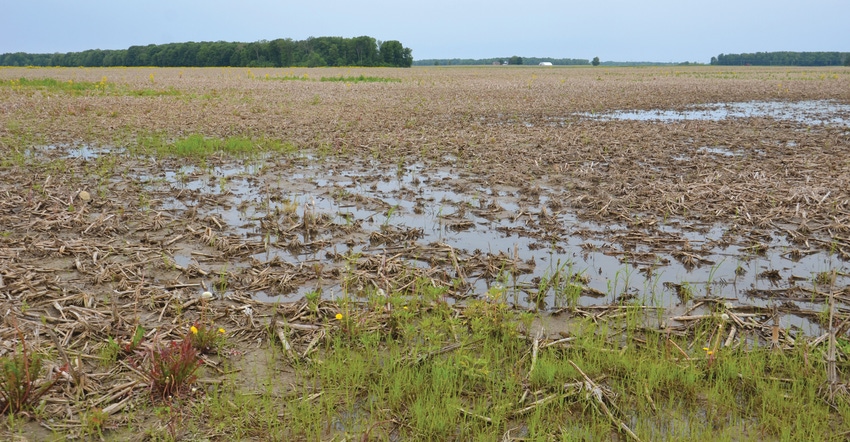
Chad Hart began his talk at the Top Farmer workshop, sponsored by the Purdue University Center for Commercial Agriculture, with a disclaimer. “They call me Dr. Doom,” he said, chuckling. “But everything I see going forward isn’t bearish, especially not long term.”
Those listening to the Iowa State University agricultural economist appreciated his Dr. Doom moniker for the short term. However, at the same time, he’s a self-proclaimed long-term bull for U.S. agriculture.
Here is a closer look:
Prevented planting acres. There will likely be an additional 12 million acres nationwide planted in 2020 that weren’t planted in 2019. “If farmers can’t find a better crop alternative, they’ll go back to corn and soybeans,” Hart said. “The question is, how many will go to corn and how many to soybeans?”
If planted corn acres hit 94.5 million nationally in 2020, at trend yield, that would produce 15.5 billion bushels. If soybean acreage climbs back to 84 million acres from 76.5 million in 2019, at the 50.5-bushel-per-acre trend yield, the national crop would be 4.2 billion bushels.
That would be lots of corn and soybeans coming to market.
Weather uncertainty. In mid-January, the three-month, long-term weather outlook from the Climate Prediction Center of the National Weather Service suggested increased chances for a wetter-than-normal winter throughout the Corn Belt and Upper Midwest. The spring outlook, going six months out, also indicated a wet pattern.
“The maps are very similar to what we saw in 2019,” Hart said. “A weather impact would be one thing that might provide crop pricing opportunities.”
However, Eric Snodgrass, a climatologist with Nutrien Ag Solutions and the University of Illinois who also spoke at the Top Farmer workshop, noted that the three-month winter outlook is only about 50% to 60% reliable. Plus, although the weather outlook maps look very similar to 2019, there are at least two important forcing functions that impact weather that are aligned differently than they were a year ago. His bottom line is, it’s far too early to assume 2020 will be a repeat of 2019.
Demand and trade. A portion of the pressure on 2020 grain prices comes from the demand side. Part comes from the trade difficulties with China, but it’s not all about China, Hart said. China is back in the soybean market, and now the pork import market from the U.S. in a big way. But there’s still a gap in U.S. exports versus production.
Fundamental change in China means it may not return to the previous level of soybean purchases, Hart said. “They have 40% fewer hogs now due to African swine fever,” he said. “There is a real question as to how many soybeans they will need.”
Slowdown in global economy. Hart attributes part of the reduction in ag exports to a slowdown in the economy of several foreign trading partners over the past year. At the same time, the U.S. dollar strengthened, which made it harder for these countries to buy U.S. goods.
Ethanol factors. Three fundamental shifts could impact ethanol demand, which in turn affects corn demand, Hart said. “The interest in electric cars is real,” he noted. “I’m seeing more electric charging stations as I travel.
“Second, automakers are producing cars with much higher fuel economy today. And third, watch behavior patterns of teenagers today. They don’t cruise the town square like their parents did. They’re home on Friday nights texting on social media. They’re driving fewer miles, using less gas.”
Beef exports. One signal to watch to gauge health of the global economy is U.S. beef exports, Hart said. As people in other countries acquire more disposable income, they spend it on protein, including beef. Once world economies rebound, Hart expects U.S. beef exports to pick up as well.
Short-term opportunities. Hart said there may still be marketing opportunities if you look for them. After charting data from USDA’s National Agricultural Statistics Service and Economic Research Service based on average prices versus farmer selling from 1980 through 2018, he noted the three months with the average highest corn price in the year are April, May and June. They’re also the three months with the least farmer selling. The pattern is similar for soybeans.
“Watch for marketing opportunities this spring,” Hart said.
Long-term trends
Growing population. Here’s where Hart becomes a long-term market bull for ag products. “There will be more people around the world in the future, and many will be in developing countries,” he explained. “Once people make basic needs, they want to trade up in what they eat, especially protein. That means increased demand for meat.”
In fact, 96% of the world’s population lives outside the U.S. Meat consumption in the U.S. has averaged 200 to 220 pounds per person over the past 40 years. It’s a mature market. But that number will grow in other countries as economies pick up and people have money for food.
Eye on India. About 17% of the world’s population lives in India today, totaling 1.4 billion people. “People don’t think of India as a market for beef because of Hindu religious beliefs,” Hart said. “Yes, 80% of the population is Hindu. That means 20% is not, and 20% of 1.4 billion is nearly 300 million people. It’s still a huge potential market. In 15 years, we will likely look at India like we look at China today. In 30 years, Africa will be in that position. We’re talking huge potential markets for U.S. ag products.”
Fixed amount of land. There are only three primary regions of very productive land in the world: the U.S., portions of South America, and Ukraine and some surrounding areas. “Grains for the future will still come from these areas,” Hart said. “Demand will increase as populations grow and more people enter the middle class, particularly in places like India, Latin America, Mexico and parts of Africa.”
About the Author(s)
You May Also Like




